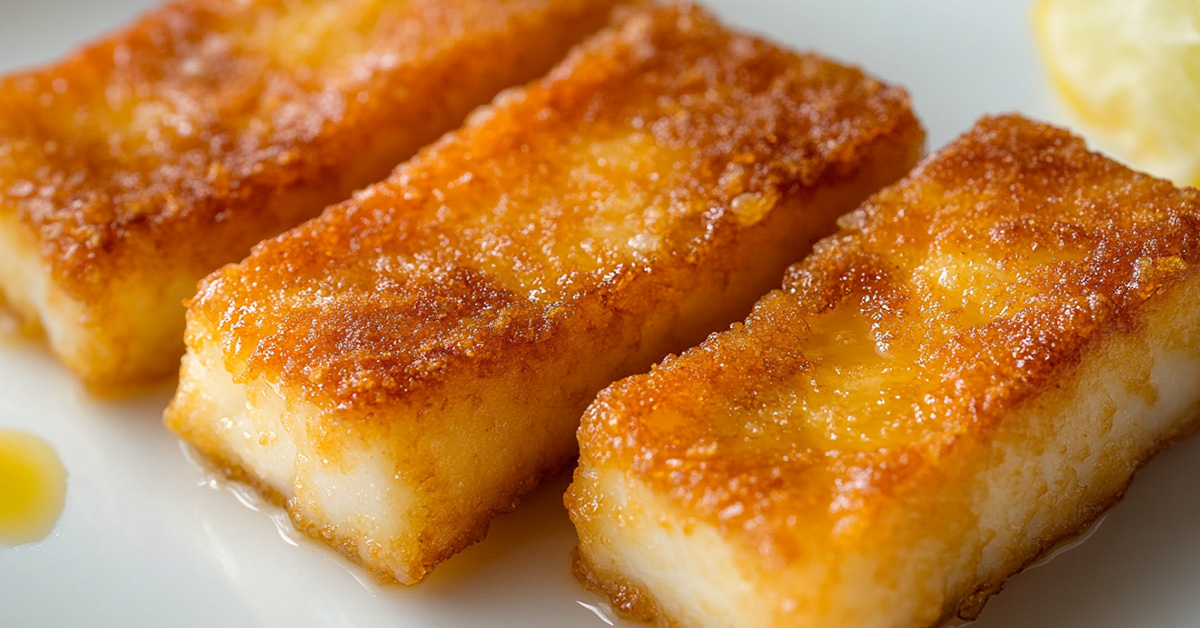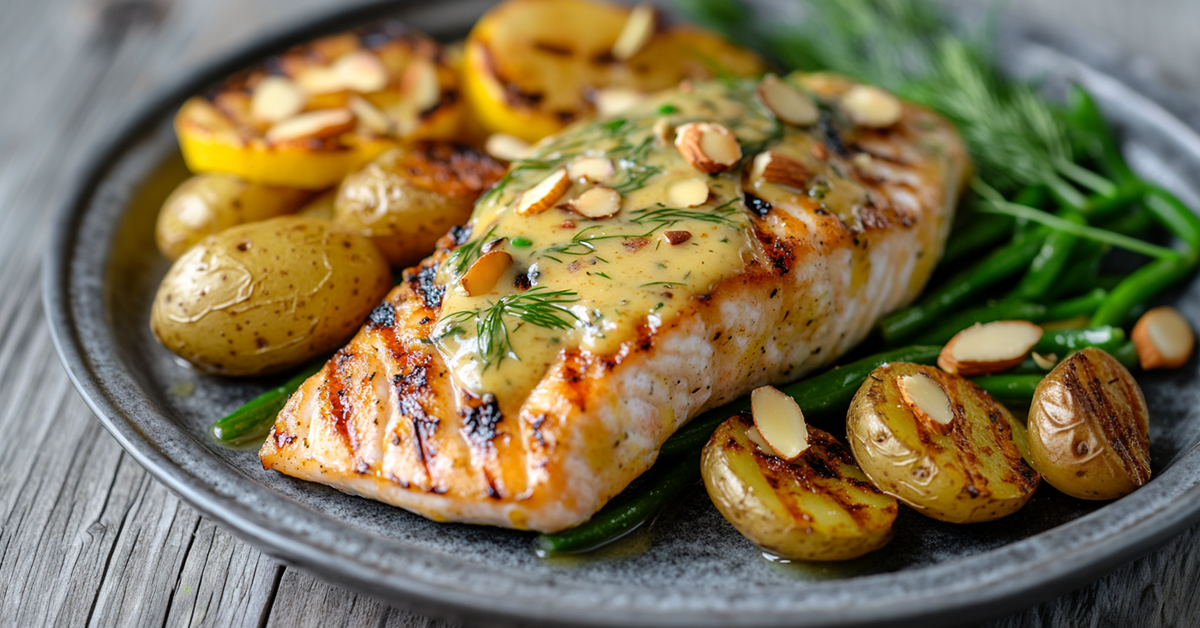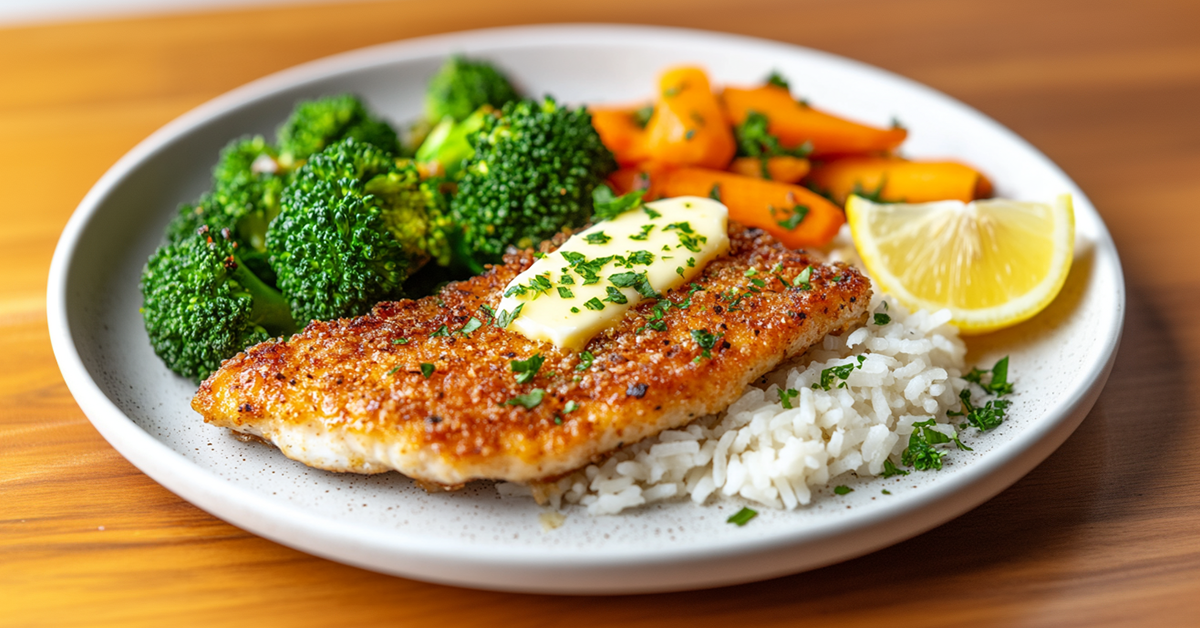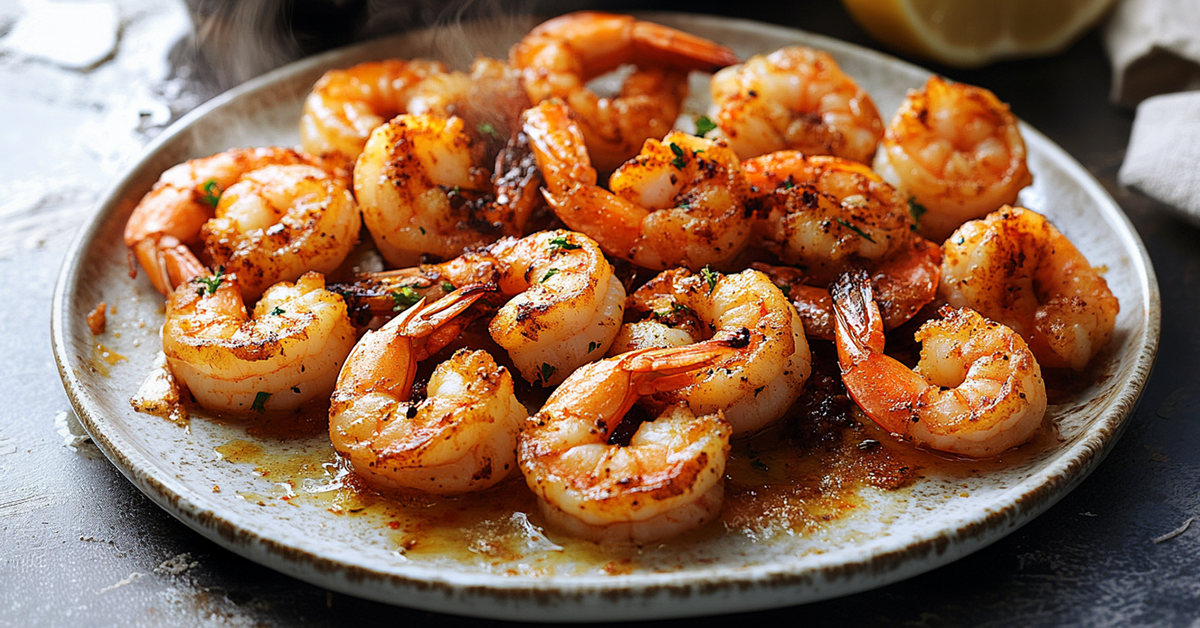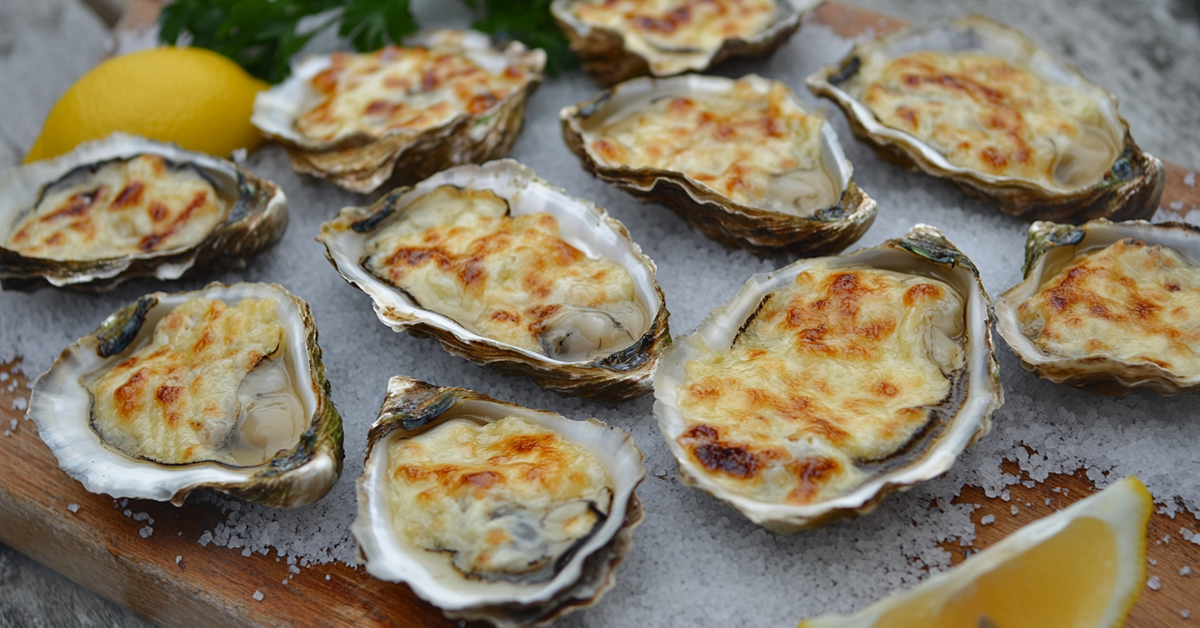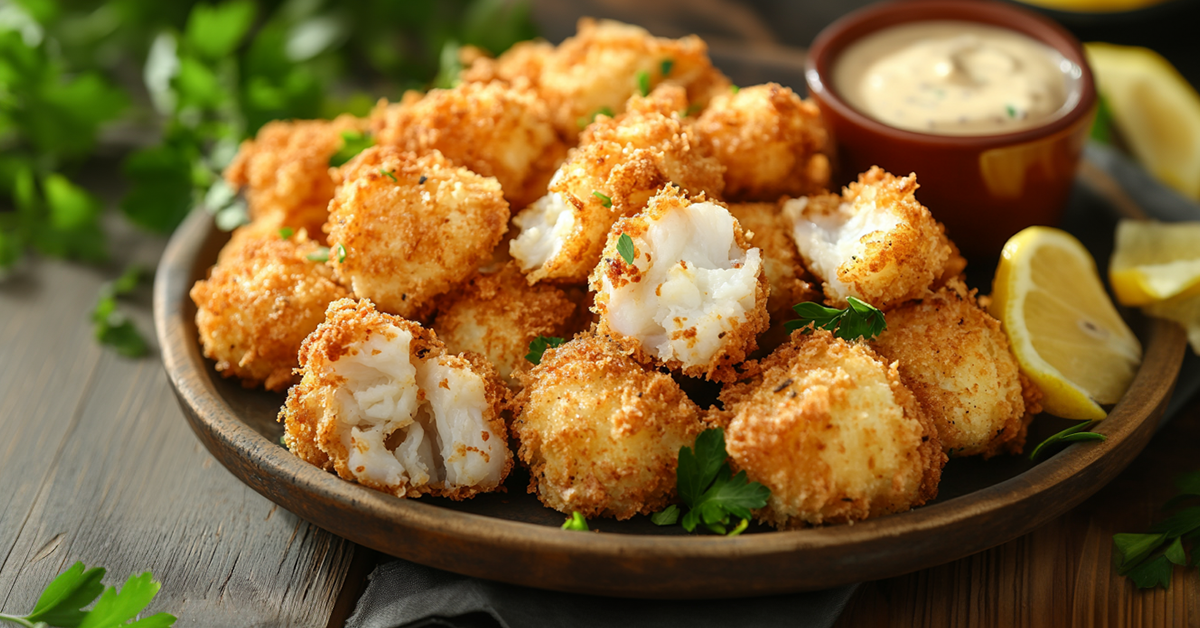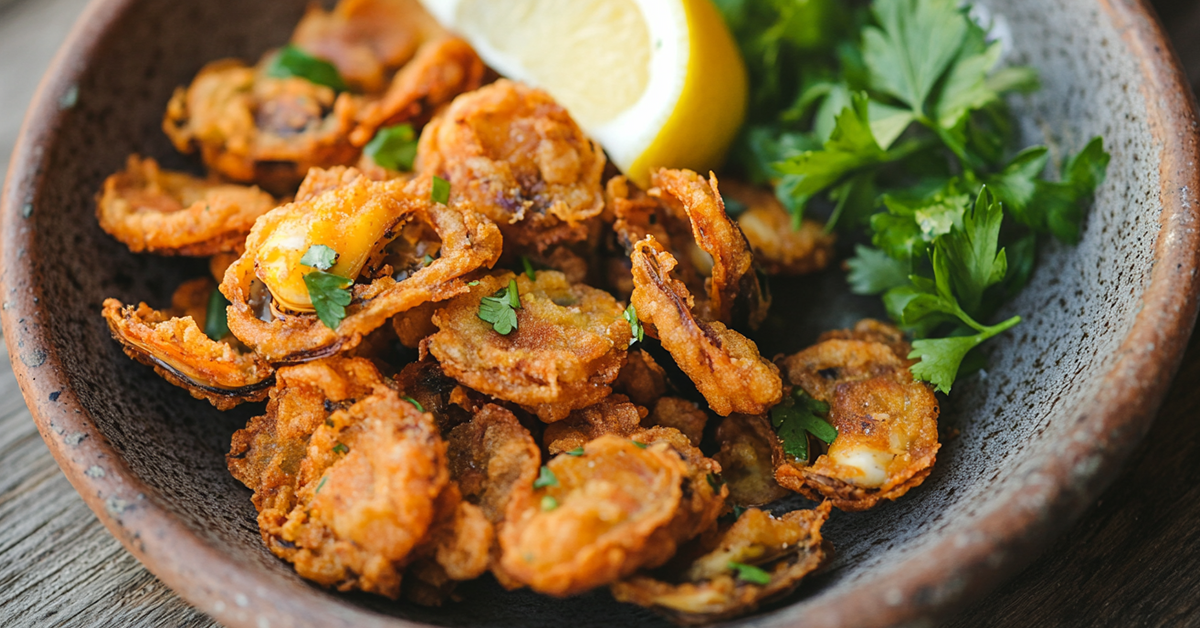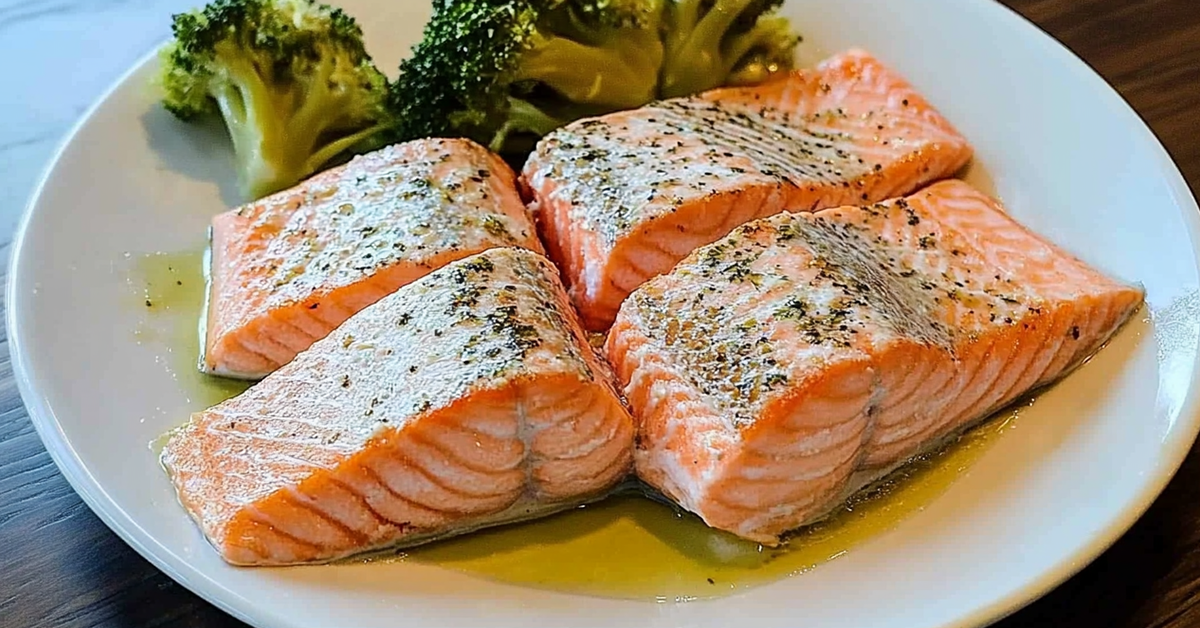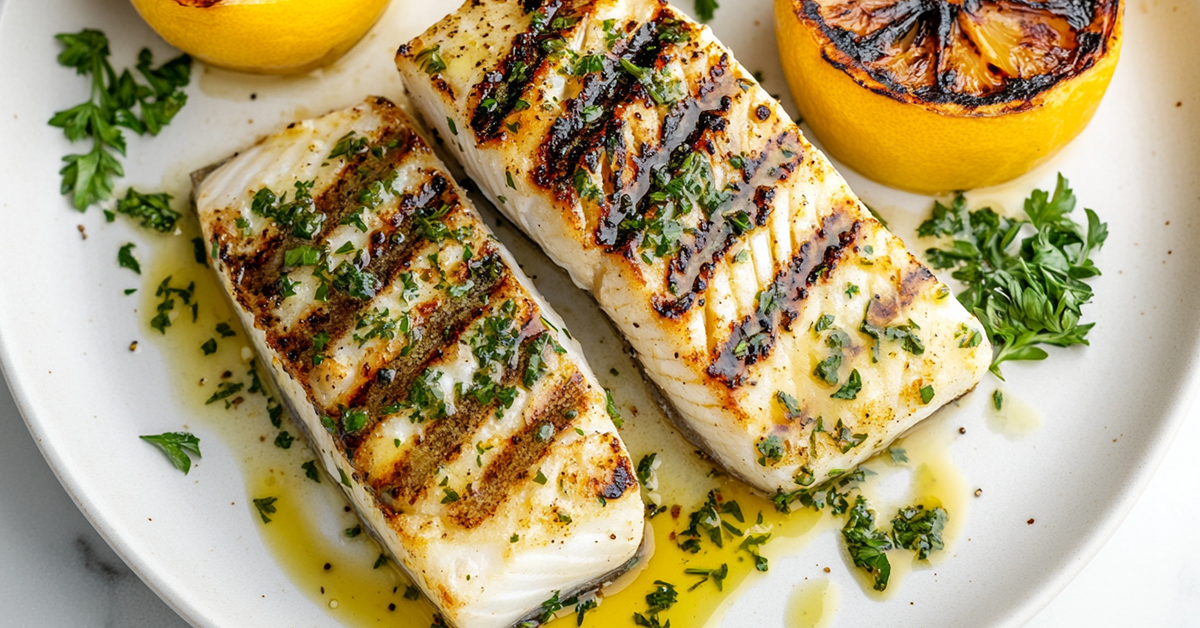A perfectly fried rockfish gives you crispy exterior and tender, flaky interior. This versatile fish turns into a restaurant-worthy dish with just a few simple ingredients and cooking techniques.
You can choose between pan fried rockfish with a light coating or deep fried rockfish with golden-brown breading. Becoming skilled at this rockfish recipe will add an impressive dish to your cooking repertoire. The perfect rockfish filet preparation awaits you.
This detailed piece shows you everything about selecting, preparing, and frying rockfish to perfection. Our step-by-step instructions will help you create a memorable seafood dinner that your guests will request again and again.
Table of Contents
What is Rockfish?
Let’s talk about rockfish – the star of our recipe. You might wonder about this fish as you learn about seafood options. The name represents a fish family found along the Pacific and Atlantic coasts. Rockfish comes from the Sebastes genus and has over 100 different species. This makes it one of North America’s most diverse fish families.
A rockfish stands out with its strong body, big eyes, and colors ranging from red to brown to black. Your local fish market might have these popular varieties:
- Red rockfish (also known as Pacific red snapper).
- Black rockfish.
- Copper rockfish.
- Yelloweye rockfish.
- Vermilion rockfish.
The fish’s firm, lean meat makes it perfect to fry because it stays together during cooking. Raw flesh shows a white to light pink color that turns beautifully opaque white once cooked. The texture is what really sets rockfish apart. It gives you medium-firm, large, tender flakes that stay moist after cooking.
The mild, slightly sweet flavor doesn’t taste too “fishy.” This makes rockfish a great choice if you’re new to seafood, especially when fried. The meat soaks up seasonings and breading flavors while keeping its subtle taste.
Most market rockfish weigh between 2 and 5 pounds, though some grow much bigger. Your fried rockfish recipe will use filets sized just right for one serving.
The best thing about rockfish is how easily it adapts in the kitchen. We’re focusing on frying here, but this fish works well with many cooking methods. Its firm texture and mild flavor create that perfect crispy crust through frying – whether you choose to pan fry or deep fry your filets.
Read also: Grilled Rockfish Recipe
Why Choose Fried Rockfish?
Want to add an impressive yet approachable seafood dish to your cooking lineup? Fried rockfish deserves a spot in your recipe collection, and you’ll love it.
The cooking experience sets this fish apart. Rockfish filets stay together beautifully during frying, unlike other fish that break apart when touched with a spatula. The meat remains intact, which makes it perfect for both pan-frying and deep-frying techniques.
Magic happens when heat meets fish. Your rockfish filet develops a golden crust while the interior stays tender and juicy. This texture contrast makes fried rockfish stand out at casual family dinners and entertaining events.
Here’s why fried rockfish should be your next cooking adventure:
- Foolproof cooking: The firm texture helps prevent overcooking
- Versatile seasoning: Works well with different spice blends and coatings
- Quick preparation: Ready to serve in under 30 minutes
- Budget-friendly: Costs less than premium fish options
- Family-friendly taste: Mild flavor appeals to seafood lovers and skeptics alike
Read also: Abalone Dish Recipe
Your pantry already has everything needed for a delicious fried rockfish dinner. Simple ingredients like flour, eggs, and seasonings turn this humble fish into a restaurant-worthy meal. The simplicity of preparation and impressive results make it excellent for weeknight dinners and special occasions.
Pan fried rockfish’s versatility shines through its compatibility with any side dish. The fish adapts to your menu plans, whether served with a light summer salad or hearty roasted vegetables. Its crispy exterior adds a satisfying crunch that enhances your chosen sides.
Rockfish proves forgiving in the frying pan. The meat’s natural moisture prevents drying out, and its firm structure lets you flip it confidently. Both cooking beginners and experienced chefs can perfect their seafood game with this exceptional fish.
Read also: Baked Rock Fish Recipe
Tips for Selecting the Best Rockfish
A successful fried rockfish dish starts with picking the right fish at the market. Your recipe’s outcome depends on the fish’s quality.
The fish’s eyes tell you a lot at the counter. Start with the eyes of whole rockfish – they should appear clear, bright, and slightly bulging, not cloudy or sunken. Fresh gills display a rich red color instead of brown or grayish tones. Fresh filets feel firm and springy, bouncing back after a gentle press.
These signs indicate fresh rockfish that will deliver excellent results:
- Flesh should be translucent and glossy, not dull or discolored.
- A mild, clean ocean scent – not a strong fishy smell.
- Skin should be shiny and metallic, with scales firmly attached.
- Filets should be moist but not slimy.
- No brown or yellowish discoloration along the edges.
For the best frying results, pick rockfish filets with uniform thickness. This will give a perfect golden-brown crust you want to achieve. Pan-frying works best with filets about 1 to 1½ inches thick – enough to stay juicy without burning the outside before cooking through.
Fresh is best, so buy rockfish the day you plan to cook it. Store it in your refrigerator’s coldest part and use it within two days. Wrap it in wax paper or plastic wrap and place it on frequently replaced ice.
Frozen rockfish packages should be solid without freezer burn or ice crystals. Temperature changes can affect quality. The packaging should be intact, without tears or crushed areas.
A main course serving needs about 6 ounces per person. This amount allows for trimming while providing generous portions of crispy fried rockfish. The fish shrinks during cooking, so adjust your portions accordingly.
You may like also: Fried Grouper Recipe
Your local fishmonger can help you make the right choice. Ask them about delivery dates and frying recommendations. They’ll clean and filet the fish too, saving you prep time at home.
Popular Methods for Frying Rockfish
You can make crispy, golden-brown fried rockfish in several ways. Each technique brings something special to your plate. Let me show you the quickest ways to turn rockfish filets into a delicious meal.
Pan-frying lets you retain control over your rockfish. The method works great with breaded and unbreaded filets. It creates a crispy exterior while keeping the fish’s natural moisture. Your pan should be medium-high with enough oil to coat the bottom. The oil is ready when it shimmers.
Deep-frying needs an oil temperature between 350-375°F. This creates an even golden crust and cooks the fish quickly to seal in its juices. The method is perfect when cooking for a group since you can fry multiple pieces at once.
Your oil choice makes much difference in how the fish turns out. Here are the best picks:
- Vegetable oil – neutral flavor, high smoke point.
- Canola oil – light taste, affordable.
- Peanut oil – ideal for deep-frying, adds subtle flavor.
- Grapeseed oil – clean taste, perfect for pan-frying.
The shallow-frying technique sits between pan and deep-frying. The oil should reach halfway up the fish’s sides. You’ll get a crispy exterior from oil contact and gentle cooking from heat circulation.
Your rockfish coating options are plenty. A light dusting of seasoned flour creates a crispy crust that’s perfect for pan-frying. Beer batter or breadcrumb coating gives you that satisfying crunch in deep-frying. Success with any coating depends on how well it sticks to the fish. Pat your filets dry and let the coating rest before frying.
Time your cooking right whatever method you pick. A 1-inch thick filet needs 4-5 minutes per side in pan-frying. Deep-frying takes 5-7 minutes total until the coating turns golden brown and the fish flakes with a fork.
You may like: Anjal Fish Fry Recipe
Note that cooking in batches works best. Overcrowding the pan or fryer drops the oil temperature. This leads to greasy, soggy fish instead of crispy ones. A low-temperature oven keeps your first batches warm while you finish the rest.

Fried Rockfish Recipe
- Total Time: 15 minutes
- Yield: 1 serving 1x
Description
You’ll love this delicious seafood dish that combines crispy coating with tender, flaky fish. Simple ingredients and easy techniques come together to create a memorable meal that works perfectly for weeknight dinners and special occasions.
This pan-fried rockfish recipe gives you a perfectly crispy exterior while the fish stays naturally moist. You’ll create restaurant-quality results in your own kitchen with just a handful of ingredients and about 15 minutes of cooking time.
Ingredients
- 1 (6-8 oz) rockfish filet.
- Salt and pepper to taste.
- High-heat cooking oil.
- ½ cup flour.
- ½ cup cornmeal.
- 1 large egg.
- 2 tablespoons mayonnaise.
- 1 tablespoon Dijon mustard.
- 1 teaspoon garlic powder.
Instructions
- Use paper towels or a tea towel to pat your rockfish filet completely dry.
- Score the fish by making shallow cuts on the darker side of the filet with a sharp knife.
- Season both sides of the filet generously with salt and pepper.
- Heat your skillet over medium-high heat. Add just enough oil to cover the pan’s bottom and wait until it shimmers.
- Mix the flour, cornmeal, and seasonings in a shallow dish while the oil heats.
- Whisk the egg, mayonnaise, and Dijon mustard together in a separate bowl.
- Dip the seasoned filet in the egg mixture, then coat it well in the flour mixture.
- Place the coated filet in the hot oil with care. Press down gently with a fish spatula so it makes good contact with the pan.
- Let it cook without moving for about 2 minutes until the filet releases easily from the pan.
- Flip it carefully and cook for another 1-2 minutes until golden brown and cooked through.
Notes
Your fish should be as dry as possible before coating to get a crispy crust.
The oil temperature should stay between 350°F to 375°F for the best results.
The mayonnaise and Dijon mixture helps the coating stick properly – don’t skip it.
- Prep Time: 5 minutes
- Cook Time: 10 minutes
- Category: Seafood
- Method: Frying
- Cuisine: American
Serving Ideas for Fried Rockfish
Your perfectly cooked fried rockfish can become an impressive meal with the right accompaniments and presentation. The crispy exterior and tender interior of rockfish needs companions that improve rather than overshadow its delicate flavor.
Classic side dishes pair with your fried rockfish beautifully:
- Creamy coleslaw with tangy vinaigrette.
- Roasted fingerling potatoes with herbs.
- Grilled asparagus or green beans.
- Lemon-butter rice pilaf.
- Fresh garden salad with light citrus dressing.
- Corn on the cob (summer favorite).
- Garlic-sautéed seasonal vegetables.
Your sauce selection can reshape the scene of your fried rockfish. Homemade tartar sauce offers a traditional approach, while remoulade sauce adds a Cajun twist. A simple lemon-butter sauce lets the fish’s natural flavors shine and adds a touch of richness.
The presentation needs visual appeal through color and texture contrasts. Your golden-brown rockfish filet looks stunning on a bed of bright green vegetables or next to vibrant roasted bell peppers. A lemon wedge and fresh herbs add visual interest and provide fresh flavors that complement the fish.
Your fried rockfish can transform into spectacular fish tacos. The crispy filets layered in warm tortillas with shredded cabbage, fresh pico de gallo, and chipotle cream sauce create an exciting weeknight dinner. This modern twist will please the whole family.
Seasonal serving suggestions help you enjoy your fried rockfish year-round. Summer calls for fresh corn and tomato salad. Fall pairs well with roasted root vegetables. Winter welcomes hearty sides like creamy mashed potatoes, while spring brings light preparations with fresh peas and mint.
Restaurant-style presentation requires warmed plates garnished with microgreens or fresh herb sprigs. Pickled vegetables on the side add visual interest and pleasant acidic contrast to the rich, fried coating.
Read also: Fried Trout Fish Recipe
The rockfish’s crispiness peaks right after cooking. Your dinner party’s success depends on timing the side dishes to finish as the fish comes out of the pan. This attention to detail will give a perfect meal where every element shines.
Health Benefits of Rockfish
Rockfish offers more than just great taste and cooking versatility – it brings many health benefits to your plate. The nutritional value makes it a great dietary choice, even though frying adds calories. Moderation is important.
Your body will thank you because each rockfish filet contains high-quality protein. This lean protein helps maintain muscle mass effectively and supports your body’s functions. Rockfish stands out with its impressive nutrient profile that has:
- Vitamin D for bone health and immune function.
- B vitamins for energy metabolism.
- Selenium for antioxidant protection.
- Potassium for heart health.
- Magnesium for muscle and nerve function.
- Phosphorus for strong bones and teeth.
Rockfish serves as an excellent protein source with omega-3 fatty acids, though levels are moderate compared to fattier fish. These essential fatty acids boost brain health and reduce inflammation naturally. Fried rockfish retains these beneficial compounds, though cooking may affect some components.
The protein content keeps you satisfied longer, which makes rockfish great for weight management. Extra calories from frying should be considered carefully. You can maximize health benefits by using heart-healthy oils and watching portion sizes.
Rockfish’s selenium content boosts your immune system by acting as an antioxidant. This mineral works with vitamin E to protect cells from damage and enhance overall health. Your thyroid function improves from rockfish’s nutrient combination, which helps maintain proper metabolism.
The frying process adds fat and calories, but healthier preparation choices exist. Pan-frying with minimal oil works better than deep-frying, and oils like olive or avocado offer better monounsaturated fats. Balance is key – enjoy fried rockfish as part of a varied diet with plenty of vegetables and whole grains.
References:
– DrAxe
– National Institutes of Health
Note that your cooking method affects the dish’s final nutritional profile. Water-soluble vitamins might decrease during cooking, but protein and minerals stay stable mostly. You can alternate between fried preparations and other methods like baking or grilling to enjoy rockfish’s full health benefits while watching calories.
Nutrition Facts for Fried Rockfish
The nutritional profile of fried rockfish can help you plan your meals better and control portion sizes. Your cooking method and coating choices will change these values, but here’s what you can expect from a typical serving.
A 6-ounce portion of fried rockfish makes a filling main course. The way you cook it affects the final nutritional values quite a bit. Here’s how different cooking methods stack up:
| Cooking Method | Calories per 6 oz | Added Fat (g) |
|---|---|---|
| Pan-fried | 250-300 | 8-12 |
| Deep-fried | 350-400 | 15-20 |
| Light breading | 200-250 | 5-7 |
Your fried rockfish packs these main nutrients:
- Protein: 20-25 grams per serving.
- Total fat: varies by cooking method.
- Carbohydrates: 10-15 grams (from coating).
- Dietary fiber: 0-1 gram.
- Cholesterol: 55-65 mg.
Your choice of coating changes the final nutritional values by a lot. Light flour dusting adds fewer calories than thick batter, while panko breadcrumbs sit somewhere in between. Oil absorption changes based on cooking temperature and time.
Oil temperature during frying is a vital factor in tracking daily intake. Oil at the right temperature (350-375°F) means less absorption and lower fat content. Cool oil leads to more absorption, which adds extra calories and fat to your meal.
Your seasoning choices determine the sodium content in fried rockfish. Simple salt seasoning adds about 300-400mg of sodium per serving, but this number goes up with extra seasonings or marinades. Herbs and spices make great alternatives to salt-based seasonings if you’re watching your sodium intake.
For calorie-conscious diners, pan-frying with minimal oil balances flavor and nutrition well. This method adds 30-40% fewer calories than deep-frying and still gives you that crispy exterior. Paper towels can help remove extra oil after cooking to cut down calories even more.
References:
– Eat This Much
– Healthline
These nutritional values are averages, and your cooking method will change the final numbers. Your coating thickness, oil type, and cooking time all shape the nutritional profile of your fried rockfish dish.
Common Mistakes to Avoid When Frying Rockfish
Even seasoned cooks struggle with fried rockfish. Let’s look at the most common mistakes and their fixes to help you create that perfect crispy, delicious dish.
These are the main pitfalls you need to avoid when frying rockfish:
- Not patting the fish dry really well.
- Skipping the rest time after coating.
- Using oil at the wrong temperature.
- Overcrowding the pan.
- Flipping the fish too early or too often.
Moisture is the Enemy of Crispiness The first vital step is to dry your rockfish filets well. Extra moisture will stop proper browning and leave you with soggy coating. Take an extra minute with paper towels to get your filets completely dry before you season or coat them.
Temperature Control Matters Getting your oil to the right temperature is a make-or-break factor. Here’s a simple guide to nail the perfect temperature:
| Frying Method | Ideal Temperature | Signs It’s Ready |
|---|---|---|
| Pan-frying | 350°F | Oil shimmers |
| Deep-frying | 375°F | Oil bubbles gently around a wooden spoon |
The Coating Conundrum You might want to start cooking right away, but your coated fish needs 5-10 minutes to rest. This step helps the coating stick better and prevents it from falling off during frying.
Space: The Secret Ingredient A crowded pan leads to uneven cooking and soggy fish. Your rockfish filets need room to develop that golden-brown crust. It’s better to cook in batches than to rush and end up with mediocre results.
The Flip Factor Don’t keep checking and flipping your fish. Moving it too soon will tear the coating and stop proper browning. Wait for golden-brown edges before that first flip. After flipping, let it cook without disturbing it.
Oil Selection Errors Your choice of oil affects both flavor and texture. Pick oils with high smoke points like vegetable, canola, or peanut oil. Olive oil isn’t your best choice for high-temperature frying since it can break down and turn bitter.
Temperature Recovery Time Cold fish will drop your oil temperature substantially. Give the oil time to heat back up between batches. This patience will give you consistent results for all your servings.
Seasoning Timing Season your rockfish before frying. Mix seasonings into your coating or season the fish before you coat it. This locks in flavors during cooking instead of leaving them on the surface.
Note that perfect fried rockfish comes down to careful attention and patience. You can easily avoid these common mistakes with good planning and technique.
FAQs About Fried Rockfish
Looking to make the perfect fried rockfish? Let’s tackle your most common questions to help you become skilled at this delicious dish.
How do I know when my fried rockfish is fully cooked? The fish is ready when it flakes easily with a fork and reaches an internal temperature of 145°F. You’ll see opaque white flesh throughout and a golden brown coating. Pan-frying usually takes 3-4 minutes on each side.
Can I prepare the coating in advance? You can mix and store dry coating ingredients in an airtight container ahead of time. The fish shouldn’t be coated until you’re ready to cook it. The coating gets soggy if breaded fish sits too long.
What’s the best way to store leftover fried rockfish? Leftovers stay good in an airtight container in the fridge for up to 2 days. Reheating works best in an oven or toaster oven at 350°F for about 10 minutes – this helps keep the crispiness. The microwave makes the coating soggy, so it’s best to avoid it.
Why does my coating fall off during frying? This problem typically happens because of:
- Fish surface too wet before coating.
- Oil not hot enough.
- Moving the fish too soon during cooking.
- Coating not rested before frying.
Can I freeze fried rockfish? Freezing isn’t ideal since it affects both the fish and coating’s texture. If you need to freeze it, wrap individual portions in foil and put them in a freezer bag. Use them within a month.
Here’s a quick troubleshooting guide for common issues:
| Problem | Likely Cause | Solution |
|---|---|---|
| Greasy fish | Oil too cool | Maintain 350-375°F |
| Uneven browning | Uneven coating | Pat dry, coat thoroughly |
| Burnt exterior | Oil too hot | Use thermometer to monitor |
| Raw center | Filet too thick | Cut to even thickness |
What’s the difference between pan-fried and deep-fried rockfish? Pan-frying needs less oil and gives you better control. Deep-frying browns more evenly and works better with thick batters. Both methods create great results when done right.
How can I make my fried rockfish healthier? These modifications help:
- Use light coating instead of thick batter.
- Choose heart-healthy oils.
- Pan-fry instead of deep-fry.
- Remove excess oil with paper towels.
- Air-frying works as an alternative.
Why does my oil smoke when frying rockfish? Smoking oil means it’s too hot or you’re using oil with a low smoke point. Oils like canola, vegetable, or peanut oil work best since they have higher smoke points that suit frying.
Note that practice leads to perfect fried rockfish. Your first try might not match restaurant quality, but you’ll get better at timing and technique with each attempt.
Conclusion
Fried rockfish delivers a delicious combination of simplicity and impressive results. The success of this versatile fish depends on careful selection, proper preparation, and mastering simple frying techniques. The right knowledge about temperature control, coating methods, and common pitfalls will help you create perfectly crispy, golden-brown filets every time.
This seafood dish packs substantial nutritional benefits through its lean protein content and essential nutrients, despite being fried. You should make this seafood star your next kitchen project. Pan-frying gives better control while deep-frying creates that extra-crispy coating. Your confidence will grow with practice, and each preparation will enhance your understanding of timing and technique that guides you to consistently delicious results.

